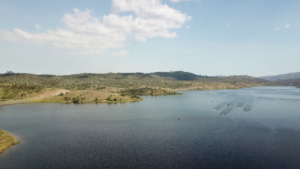
23 Mar 2021
Keep it clean. Rowing Queensland safeguards their water
Rowers around the world are increasingly aware of the importance of protecting the environment. From the water we row on to the plants and animals that share the shore with our boathouses and docks, rowers are in contact with the natural world more than most in today’s urbanised world.
The idea that rowers can be part of the solution to environmental issues is at the heart of World Rowing’s Clean Water initiative. It is also central to the efforts of Rowing Queensland in developing an environmentally sustainable model for operating their Queensland State Rowing Centre near Brisbane, Australia.
World Rowing spoke with Andrew Service, Rowing Queensland’s High Performance Manager, about his state rowing association’s ongoing work to maintain a positive environmental impact of operations at their premier venue.
Native trees and emu parades
“For us the main areas of focus have been on keeping the water and shore clean and healthy while also eliminating rubbish from the environment,” says Service.
Water awareness is something Australians are brought up to respect and care for says Service. “In Australia, being such a dry place, we are always watching our water use and how to keep it clean because there are times when we don’t have a lot of it.”
On the water, Service says this means, “Making sure we are not dropping fuel and oil into the water. Using new four stroke engines and regularly servicing them has helped with that.”
“On land, we’ve planted 200 trees – all native species,” he says pointing out the importance to the ecosystem of choosing local trees. “The big thing in Australia is that they are drought tolerant.”
The facility also has a number of water tanks, capturing rainwater for use such as washing equipment.
Besides taking on big contributors to environmental degradation, Rowing Queensland also works with rowers, coaches and spectators to preserve clean water for years to come.
Procedures include cutting the use of single-use drink containers, drinking straws and plastic or Styrofoam food containers. Plenty of bins around the site help stop litter from entering the water or surrounding environment.
“The response from people has been fantastic,” says Service. “We have big school events here with a thousand students and the younger generation especially are right on top of it.”
“Every young school student in Australia does something called an emu parade at the end of school events, and we do that after regattas here too.” An emu parade,” explains Service, “is when people form a horizontal line and walk along, bending over – as Emus do – to pick up any rubbish as they go.”

Starting small with big plans
“We didn’t have a huge plan at the beginning,” says Service of ten years before. He and others simply wanted to do something to help the environment around their new water way with the long-term plan to do more as they were able.
“The Wyaralong Dam was built as a water source in 2011,” he explains. “It was due to take many years to fill up, but in actual fact it took a couple of weeks because of a once in a century rain fall.”
When Service and other rowers saw the full reservoir, they were understandably eager for the chance to get boats out on the new lake. Fortunately, the environmental focus of both the Queensland state government and Seqwater, the water management agency who had built the dam, lined up well with Rowing Queensland’s vision for their new rowing centre.
“We were committed to helping the ecosystem grow around the water,” Service says pointing out that because of the rapid filling up, the land around the reservoir was pretty barren.
Environmental stewardship
In the years since, the Queensland State Rowing Centre has grown and is now a popular venue for racing throughout the year.
“A big part of it was making sure that we did all the right things environmentally,” says Service of the centre’s growth and success. “Each time we grow the facility, we step up our environmental initiatives.
“First, we enquired about training, then built a good relationship. We had to jump through a number of hoops when we asked about putting in a 2k course, but now we have a great facility. Because it is such a good water way, people are eager to use it all the time, so we’ve had to think about our footprint.”
Service hopes that other rowing venues in Queensland and elsewhere can integrate some of the environmental measures that have proven so beneficial at the Wyaralong reservoir.
“We are looking to this as an example of making the other Queensland locations better,” he says. “We’re quite proud of how many events we have here and how little impact it has on the natural environment.”
“In Australia, we just don’t have much good water,” says Service about the importance of environmental stewardship. “There is an obligation for rowers in Australia to live on those water ways with absolutely no impact. If it was a choice between rowing and drinking water, it would not be rowing. The onus is on us to make sure it is run environmentally.”
“We want to be seen as a group that contributes to clean water,” he says. “We hope to support World Rowing in this and are doing everything on and off the water to make sure our water way is clean with as little impact as possible.”
Find out more about World Rowing’s Clean Water initiative, Kafue River & Rowing Centre here.
To find out more from Andrew Service: hp@rowingqld.com.au

